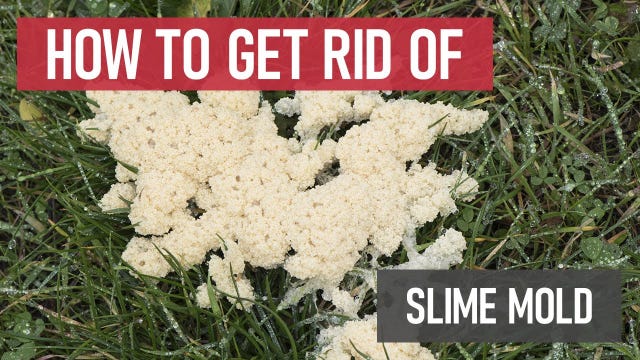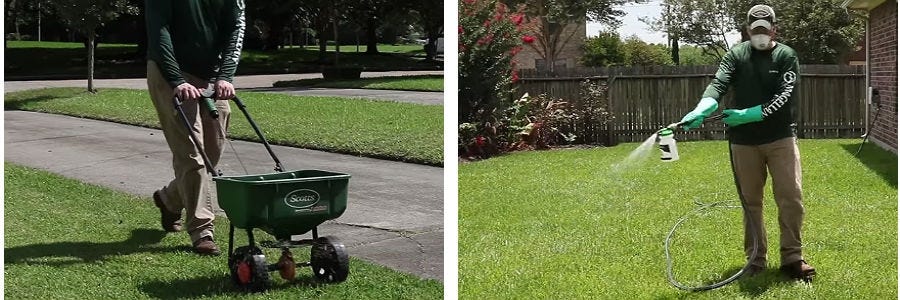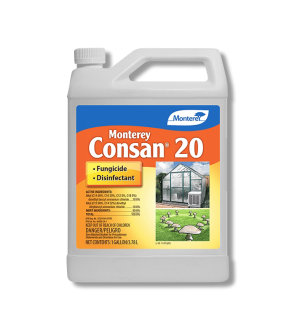Gain access to personalized product screening, the best pricing, rewards, and more!
Most Effective Products
Slime Mold Control: How To Get Rid of Slime Mold
This page is a general slime mold control guide. Using the products and methods suggested, you will get control of the disease known as slime mold. Follow this guide and use the recommended products; we guarantee 100% control of slime mold.
Slime mold is not technically a lawn disease but a fungus that lives on and eats dead organic matter. It is found typically in moist soil conditions and has characteristics such as grass blades and a translucent, slimy, creamy-white growth on the soil's surface.
If left for a few days, this slimy growth can morph into various colors, such as cream, pink, blue, orange, or red. The individual spores of slime mold can even merge and can be dark or whitish-colored.
Slime mold can come and go depending on the weather conditions being ideal for it and can become widely prevalent if the conditions allow it to thrive. If you are dealing with slime mold on your lawn in a heavy, concerning amount, fungicides may be the way to treat it.
If you have noticed slime mold on your lawn, our DIY treatment guide will show you how to eliminate it with professional fungicides.
Identification
Before proceeding with a treatment program, you must be sure you are dealing with a slime mold infestation. Careless identification can lead you to use the wrong treatment methods, wasting time and money. Depending on the stage of life it is in and the environmental conditions, the slime mold will vary in appearance, but there are some common characteristics to know what slime mold looks like:

- There are two types of slime mold: cellular and plasmodial. Cellular slime mold, rarely visible to the naked eye, may release spores that develop a volcano-shaped fruiting body.
- Plasmodial slime mold will appear as a large mass of blobs or ball-like or web-like slime. This fungi moves toward their streaming cytoplasm, giving it a fan-shaped or shuttle-like pattern. Plasmodium may rapidly dry out, and disintegrate during the mornings, spreading spores through the air.
- Typically, slime mold is seen in bright colors like yellow, red, orange, or creamy to gray-white. However, as it dries out, it will turn brown to tan. If you break apart the slime mold, you will find a dark brown to black core. On lawns, it may appear as slimy white patches that are circular or irregular in shape. The slime mold's frothy appearance often gives the impression of dog vomit, hence the nickname. Generally, they can be seen as patches that measure 4 to 8 inches in diameter.
Use the image and description above to help you correctly identify slime mold on your property. If unsure, contact us and send a photo of the plant symptoms via email or in person at one of our store locations. We will then help you identify the disease and suggest treatment options.
Inspection
Once it is confirmed that you are dealing with slime mold, you can move on to inspection. During this phase, you will locate all areas where slime mold develops and observe the conditions allowing it to thrive. This information will help you know where to focus your fungicide applications.

Where to Inspect
Slime molds can be found in various places. However, most are found on forest floors, soil, logs, wood chip mulches, lawns, garden beds, ornamental landscapes, foundation walls, woody or herbaceous plants, fallen leaves, and other damp habitats.
What To Look For
Slime mold commonly occurs in late summer through fall, but certain species can become active as early as spring. They usually emerge after wet weather in moderate temperatures.
When inspecting for slime mold, look for disease-like symptoms in turf or plasmodium blobs. Slime molds also commonly appear in damp mulch, plant beds, and soil and typically disappear in hot and dry weather.
Treatment
Before applying chemicals to your lawn, we suggest wearing the proper safety equipment (PPE) to prevent chemicals from coming into contact with your eyes or skin.
Unfortunately, few products are specifically labeled to treat slime mold. Our recommendation for treating slime mold is Monterey Consan 20, which will work to control slime-forming fungi.
Step 1: Measure and Mix Monterey Consan 20

Determine how much Monterey Consan 20 to use by measuring the square footage of the treatment area. To do this, you will need to measure the length and width of the treatment area in feet, then multiply them together (length x width = square footage).
For lawn treatments, apply 2 tablespoons (1 oz.) of Monterey Consan 20 per 1 gallon of water. You will apply one gallon of solution for every 50 square feet of lawn.
Depending on the size of your treatment area, you will use a handheld pump or backpack sprayer.
Use a fan or cone-shaped spray pattern to ensure the grass blades and foliage are evenly coated.
Treat the entire lawn to prevent the spread of infection at least one foot beyond the edges of isolated diseased areas. Saturate the whole treatment area, wetting all plant and soil surfaces.
Apply treatments only when the lawn is dry or damp. Do not apply during wet or rainy weather.
Keep people and pets away from the treated area for 48 hours after application.
Step 2: Reapply Monterey Consan 20

Repeat spray applications every 10 to 14 days, as needed, to control new or established disease conditions.
Prevention
Once the slime mold has been removed, you can perform a few maintenance tasks to prevent its return.
- Cultural practices are the preferred method of control for slime mold outbreaks. Raking is usually enough to break up patches of slime mold and restore your lawn or garden.
- To further prevent slime mold development, we recommend using regular lawn care techniques to reduce bacterial and fungal growth. Reduce the shade cast on your lawn by trimming overgrown shrubbery and tree branches, rake away leaf litter and pick up any debris, regularly mow your grass to its proper height, and employ an appropriate watering schedule to provide your lawn with enough water to strengthen its roots, but not so much that will encourage disease. Most lawns require 1 inch of water every week. Apply the water all at once in the morning so it has time to seep into the ground without evaporating in the sun.
- Adjust any drainage issues throughout your property and exterior foundation.
- Aerate your lawn as needed. This will help the water, nutrients, and air to move more efficiently throughout the soil.
- Fertilize your turf according to its schedule. Over-fertilization will lead to potential slime mold growth.
Key Takeaways
What is Slime Mold?
- Slime mold is a lawn disease characterized by grass blades and the soil's surface being covered with a translucent, slimy growth that can also turn dark and in various shades.
- Slime mold usually results from a lawn that is poorly maintained and has moisture issues.
How to Get Rid of Slime Mold
- Monterey Consan 20 is our recommended product for controlling slime mold. For best results, apply this product at the right time.
Prevent Slime Mole Reinfestation
- Once your lawn has been treated, address the moisture problem with a consistent lawn care and maintenance program to prevent slime mold from returning.









